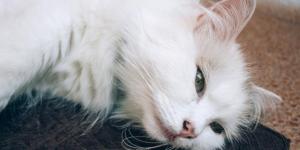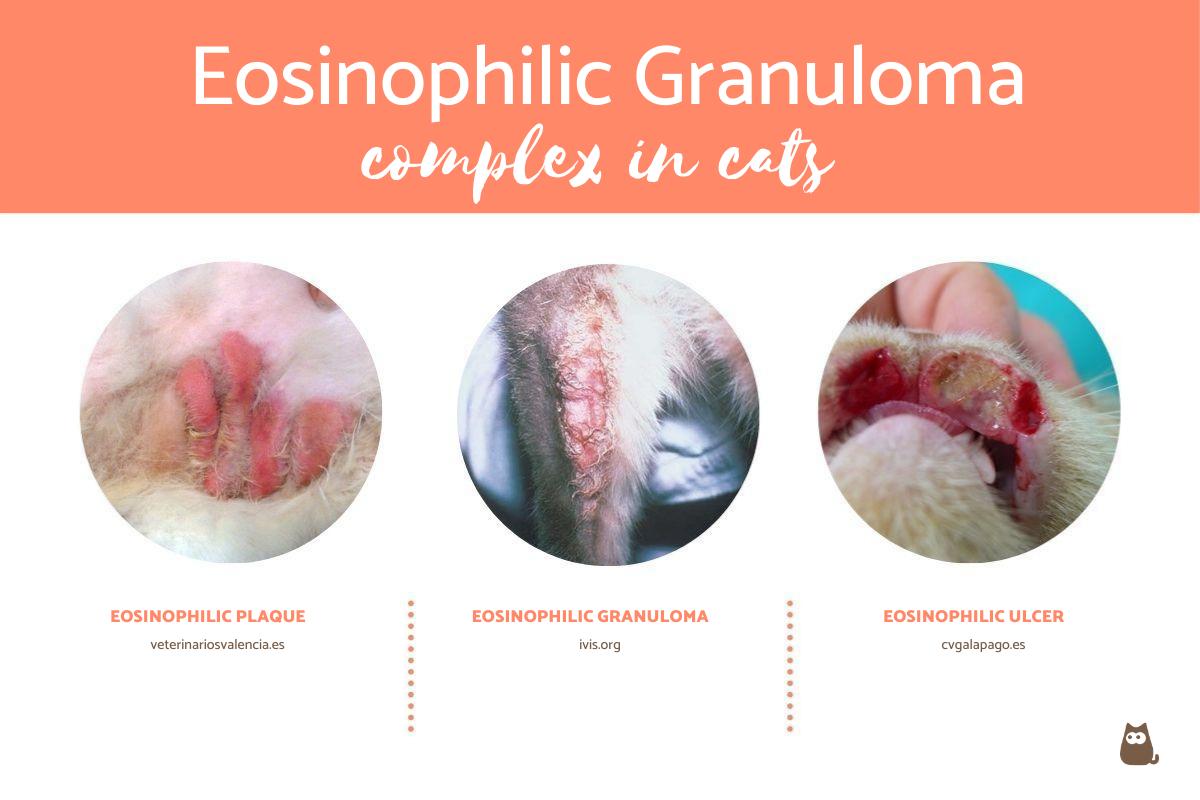What Is Eosinophilic Granuloma Complex in Cats?

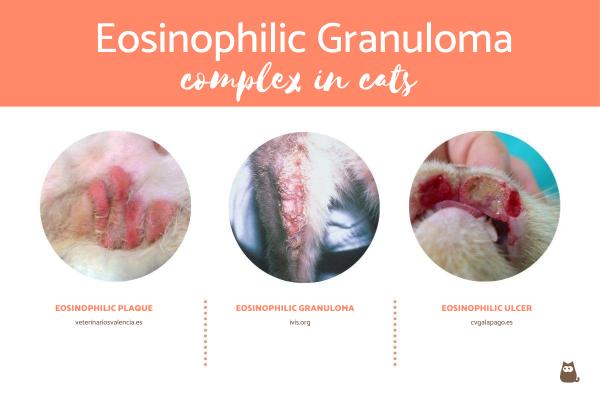

See files for Cats
Many cat caregivers wonder what eosinophilic granuloma complex is, as these diseases are quite common in cats. This complex is a group of common diseases in cats that can be present in three clinical forms: eosinophilic ulcer, eosinophilic plaque and eosinophilic granuloma.
Keep reading this AnimalWised article to learn more about feline eosinophilic granuloma complex, its types, causes, symptoms and treatment.
What is feline eosinophilic granuloma complex?
As previously mentioned, feline eosinophilic granuloma complex is a group of common diseases in cats that can present three clinical forms: eosinophilic ulcer, eosinophilic plaque and eosinophilic granuloma.
They consist of a similar histology, an inflammation with abundant eosinophils (cells that intervene in the immune response to infections, allergic reactions or inflammatory processes, among others), with the indolent ulcer presenting the least, as well as itching or pain. Degeneration of collagen tissue is seen in eosinophilic granuloma, and eosinophilic plaque is very itchy in affected cats. The definitive diagnosis that will differentiate it from other diseases with similar lesions will be histopathology, based on a biopsy, although cytology can also be very useful.
The eosinophilic granuloma complex comprises a heterogeneous group of skin, mucocutaneous, and oral cavity lesions that are patterns of a skin reaction resulting from underlying hypersensitivities. They are grouped histopathologically and clinically into three forms: eosinophilic plaque, eosinophilic granuloma, and eosinophilic ulcer. These clinical forms can occur in the same cat all at the same time or consecutively.
In all forms, the predominant eosinophilic component is common in the tissues, due to a chemotactic or attractive action made by certain agents, including microorganisms, parasites such as fleas or hypersensitivity reactions such as atopic dermatitis, adverse reaction to food or fleas or mosquitoes.
As a consequence, an inflammatory reaction occurs with permanence of the eosinophils that will cause this reaction to persist, which will lead to the formation of a bulge with eosinophil granules, which release the main basic or cationic protein and lead, in some cases, to a collagen necrosis.
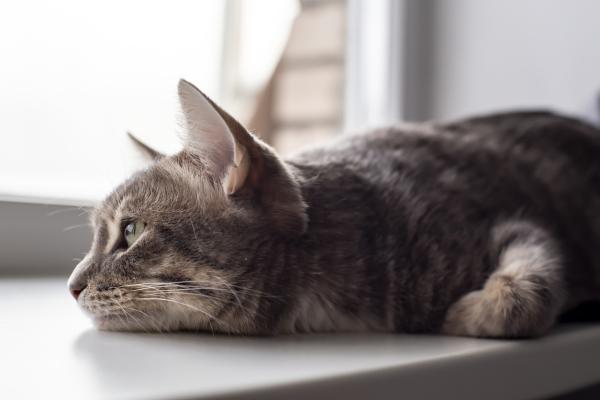
Symptoms of Eosinophilic Granuloma Complex in Cats
As we've previously stated, this complex mainly occurs in three different forms. Therefore, we will detail the symptoms that a cat can present in each of them:
Eosinophilic plaque symptoms
It is the most itchy clinical form as it causes a lot of itching, which especially affects cats between 2 and 6 years of age. It is limited to the ventral areas such as the abdomen, the inner thigh or the inguinal area and can be accompanied by enlarged lymph nodes. It is usually more frequent in spring due to sensitivity to fleas or environmental allergens, as well as food allergens.
The lesions are oval or circular in shape , devoid of hair and with circumscribed edges, simple or multifocal, highly inflammatory, itchy, reddened and constitute highly exuding plaques that cause the cat not to stop licking.
To summerize, the symptoms of eosinophilic plaque includes:
- Itchy skin
- Skin rashes
- Lesions
Eosinophilic granuloma symptoms
This is also called linear or collagenolytic granuloma, where the affected area suffers collagen damage. The lesions do not appear to be pruritic or to be predisposed to any breed, age, or sex. They are usually found as lines of raised, red, grainy, alopecic lesions on the back of the thighs, in a pattern associated with cat grooming.
Other locations are the chin, lower lip, oral cavity, and even the nose, muzzle, and the junctions of the pads and the skin of the fingers. Nodules in the oral cavity are generally found on the tongue or soft palate, and whitish focus points can occasionally be seen, corresponding to areas where collagen damage has occurred. This usually doesn't interfere with chewing or eating.
It is usually due to a hypersensitivity to fleas, allergy, atopic dermatitis or food allergy. To summerize, the symptoms of eosinophilic granuloma includes:
- Itchy skin
- lesions found as lines
- Nodules in oral cavity
Eosinophilic ulcer symptoms
This disease is also called an indolent ulcer. It mainly affects females between 5 and 6 years of age, being limited to the mucocutaneous junction of the upper lip. They are bright, well-defined alopecic lesions that thicken and increase in color (erythema), giving them the appearance of “cooked meat” and even ulcerate. However, despite their unsightly appearance, they do not cause neither pain nor itchiness.
It can start with a small bump that ulcerates and spreads towards the nose, especially if the cat licks itself repeatedly, causing more damage than the injury itself. There is some studies that suggest it may be due to an allergy to fleas or other allergens, but in many cases it is impossible to know the cause and it is classified as “idiopathic”.
Therefore, to summerize, the only symptom of eosinophilic ulcers includes a red lesion. This ulcer doesn't produce pain nor itchiness but will bring discomfort and make our cat vulnerable to other health issues. This is why it's important to bring our cat to the veterinarian as soon as we see any abnormal behaviour or abnormalities, such as a lesion.

Diagnosis of feline eosinophilic granuloma complex
Recognizing the lesions of the eosinophilic granuloma complex in cats does not usually have much complications and with a detailed anamnesis and clinical history revision, the possible allergic cause can be established by your veterinarian.
A differential diagnosis should always be made to differentiate it with other skin diseases such as:
- Mastocytoma
- Squamous cell carcinoma
- Herpesvirus
- Calicivirus
- Cryptococcosis
- Pemphigus vulgaris
- Lymphosarcoma
- Fibrosarcoma
- Plasmacytic stomatitis
Bacterial cultures and an antibiogram can be performed to provide more information on a possible bacterial origin and the appropriate antibiotic for treatment. On the other hand, skin scrapings make it possible to rule out a parasitic origin. Likewise, in the blood test, especially in granuloma or eosinophilic plaque, there may be eosinophilia (increased eosinophil count).
The definitive diagnosis will be given by cytology or biopsy, so samples of the lesion should be taken for analysis and detection of the changes associated with the lesions of the feline eosinophilic granuloma complex:
- In the cytology of lesions categorized as plaque or eosinophilic granuloma, macrophages and eosinophils will be evidenced, while in the indolent ulcer there will not be as much predominance of eosinophils, but there will be abundant macrophages and bacteria.
- In the skin biopsy, the histopathological examination shows, in the case of eosinophilic granuloma, granulomatous inflammation with focal areas of collagen degeneration surrounded by abundant eosinophils, followed by a smaller number of macrophages and mast cells and multinucleated giant cells in palisade. In the case of eosinophilic plaque, spongiotic inflammation is observed in the dermis and a predominance of eosinophils that can spread to the subcutaneous tissue; mast cells, macrophages, and lymphocytes may also be present, but in fewer numbers. In the indolent ulcer, diffuse infiltrates of eosinophils will be observed along with neutrophils, macrophages and mast cells, but in many cases the biopsies are performed in the chronic phase and lymphocytes, plasma cells, neutrophils would be seen (more the greater the degree of ulceration), macrophages and fibrosis. Histopathological analysis is very useful to rule out other diseases such as tumors or immune-mediated diseases, since the treatment and prognosis would be very different.
Treatment of feline eosinophilic granuloma complex
The most important part of the treatment is to identify and eliminate the cause of hypersensitivity or allergy. A flea treatment and elimination diet must be applied in order to find any food intolerance. However, the latter is a much longer and more complicated process, which is why these injuries are usually started with the following treatments:
- Glucocorticoids: to reduce the number of eosinophils and improve lesions. They are considered the treatment of choice for the three forms of feline eosinophilic granuloma complex. Prednisolone can be used at 2-4 mg / kg / day orally initially to reduce to 2 mg / kg every 48 hours, until the lesions disappear. You can also use doses of 4 to 5 mg / kg of methylprednylsolone acetate subcutaneously or intramuscularly every 2 weeks, with a maximum of 3 applications, or dexamethasone at a dose of 0.1-0.2 mg / kg every 24 hours at the beginning and 0.05-0.1 mg / kg every 72 hours for maintenance orally or added to food. If the corticosteroids are suspended before the lesions fully heal, they will reappear. Remember that your veterinarian will determine the best treatment and dosage for your dog.
- Immunosuppressants: to immuno-modulate the immune system through immunosuppression. Cyclophosphamide can be used at a dose of 1 mg / kg orally, 4 weekly doses up to 4-6 weeks, and the response in reducing the lesions may take between 1-4 weeks. The use of cyclosporine to reduce eosinophils is also used with a dose of 7 mg / kg every 24 hours for 4 weeks and, if a good response is appreciated, it can be decreased every other day and then twice a week. Chlorambucil is the drug of choice when cats are refractory to glucocorticoids, and can be administered together with them at doses of 0.1-0.2 mg / kg / day or every 2 days until 4-8 weeks. Once a favorable response is determined in the lesions, the glucocorticoid dose should be reduced first, followed by chlorambucil, provided that they continue to remit. With these treatments the goal is to find the lowest possible dose that allows the remission of the lesions.
- Antihistamines: is used when the cat has atopy, hypersensitivity to flea bites or idiopathic etiology. Chlorphenamine maleate and hydroxyzine hydrochloride can be used for 15 consecutive days. However, if the cause is not known or the process is very chronic or uncontrollable, corticosteroids will always be more useful.
- Antibiotics: such as amoxicillin-clavulanic acid at 12.5 mg / kg / every 12 hours or trimethoprim-sulfamethoxazole at 30 mg / kg / every 12 hours, but the best is the antibiotic determined by the antibiogram. The minimum duration of antibiotic treatment is two weeks, and it lasts for at least 10 days after cure. They are especially effective in cases of indolent ulcers, because their origin is mainly associated with bacteria.
- Fatty acids: on food as a supplement in chronic cases for 4-6 weeks. They are most effective for eosinophilic granuloma.
- Surgery, cryosurgery or radiation: for certain types of injuries that require it because they are very chronic, refractory or difficult, especially in cases of indolent ulcers.
Cats treated with glucocorticoids, blood tests, biochemistry and urine tests are required to monitor bone marrow suppression and monitor for complications such as the development of a kidney disease, urinary tract infection, or diabetes.
You should never self-medicate your cat because, as you can see, it is essential to make a diagnosis to establish the correct treatment. Take them to the veterinarian as soon as you detect any abnormalities.
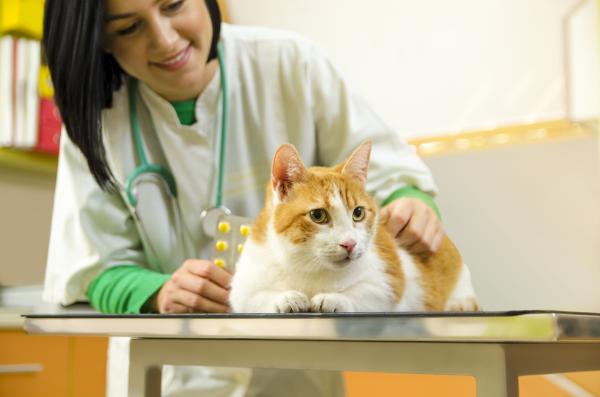
Prognosis of feline eosinophilic granuloma complex
Cats with eosinophilic granuloma complex tend to have a good prognosis when given the proper treatment and given regular check-ups. Cats that are resistant to glucocorticoids, having a higher rate of relapse of the disease, require more aggressive treatment. If the triggering cause can be determined and avoided, the injuries should disappear forever.
Choosing the right treatment for your cat is your veterinarian's responsibility. As their caregiver you must simply identify any abnormalities in your cat's appearance or behaviour and take them to the veterinarian to be properly diagnosed and treated by a professional. So, if you have seen any skin rashes, lesions or your cat has started scratching themselves more than usual, you should take them to the veterinarian as soon as possible. Early detection and treatment is always vital when treating cat diseases.
This article is purely informative. AnimalWised does not have the authority to prescribe any veterinary treatment or create a diagnosis. We invite you to take your pet to the veterinarian if they are suffering from any condition or pain.
If you want to read similar articles to What Is Eosinophilic Granuloma Complex in Cats?, we recommend you visit our Other health problems category.
- M. Schaer. (2006). Clinical dog and cat medicine . MASSON, SA
- G. Machicote. (2011). Canine and feline dermatology . Servet.
- G. Evelyn. (2014). Pathophysiology, diagnosis and treatment of oral eosinophilic granuloma in domestic felines: bibliographic review. Available at: http://cybertesis.uach.cl/tesis/uach/2014/fvr741f/doc/fvr741f.pdf




